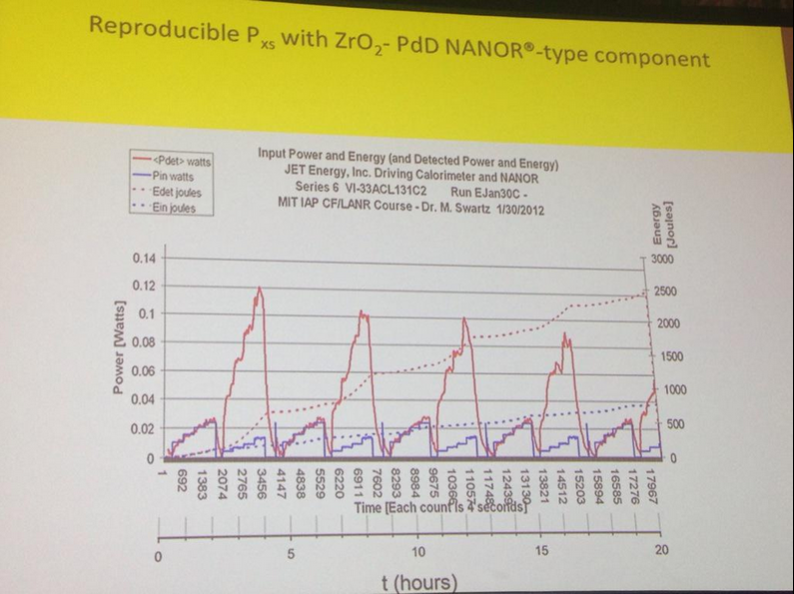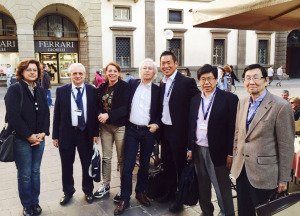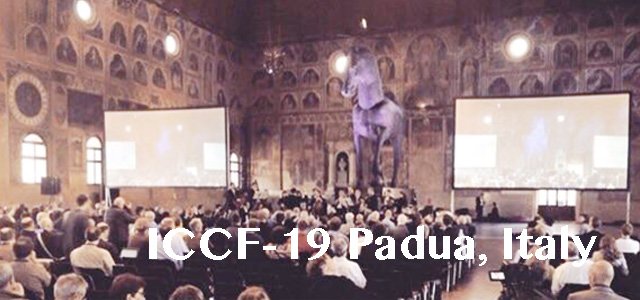Bits and pieces of new energy news continues to trickle from Padua, Italy where the 19th International Conference on Condensed Matter Nuclear Science is being held.
Cold Fusion Dog Dr. Bob wrote, “I would go so far to say that what we hear from the podium, is far from the most relevant and interest knowledge.”
Brillouin Energy Presentation Powerpoint was posted by Frank Acland
Klee Irwin of Quantum Gravity Research spoke with Cold Fusion Dog Dr. Bob; posted by Frank Acland

Photo: Poster on JET Energy, Inc NANOR reactor.
Dr. Mitchell Swartz of JET Energy was supposed to present at ICCF-19 on his NANOR technology but was unable to attend, and Dr. Peter Hagelstein stepped in and spoke about the tiny reactor. Dr. Swartz posted on his Cold Fusion Times this translation from Dr. Jean-Paul Biberian‘s original post in French about Day 1:
“David Knies of American society Coolescence studied the influence of the crystal orientation of the palladium surface and the addition of impurities on the loading of deuterium. It appears that the crystal orientation is not important. For cons, the addition of some metallic elements in very small quantities increases the load. David Nagel of George Washington University has studied the case of electrochemical cells explosions. It seems that in certain circumstances, unclear, chain reactions occur. He began by recalling the 1988 episode experienced by Pons and Fleischmann of the merger of the cubic electrode 1cm3 of palladium has melted and through the work plan. He then toured the other experiences that took place in different laboratories, and the Rossi reactor that exploded. Obviously, before placing on the market of such equipment will need to understand what happened.
Jean-Luc Payet, retired from the University of Aix-Marseille developed the theory of relativistic electrons deep could explain some of the cold fusion reactions. Francesca Sarto ENEA in Rome, has developed an in situ analysis method of the electrode surface by cyclic voltammetry which allows to know the electrode surface.
“Melvin Miles has had close relations with Martin Fleischmann, and has a large number of letters with him, he will publish soon. He revealed in particular that Martin Fleischmann had told him that the experience could not occur below 60 ° C. He also announced that in 1988 he and Stanley Pons had measured the production of helium. Peter Hagelstein, a very high level theorist MIT showed the production of X-rays with a high frequency vibration system on metallic films.
Vittorio Violante, ENEA in Frascatti showed the effect of pulsed magnetic fields in the production of excess energy in electrochemistry experiments. David Kidwell of the Washington Navy measured significant excess heat with gaseous deuterium absorption of palladium powders coated ZrO2. Orchideh Azizi, University of Missouri found that different pretreatments palladium electrodes did not change at the margin the rate of final loading of hydrogen palladium electrodes.
Jirohita Kasagi has shown that the deuterium-deuterium reactions with low energy beams of deuterium on a solid or liquid metal target occurred with reaction yields much higher than predicted by standard theories. There has low energy an anomaly. Dmitrii Filippov of the Kurchatov Institute, Russia, and collaborator Leonid Urutskoev showed that heavy nuclei could transmute under the influence of very strong magnetic fields.
Hioki Tatsumi, Toyota in Japan has studied the loading of deuterium in mesopores loaded palladium. Akira Kitamura of Technova company in Japan showed excess heat in experiments with palladium alloy powders and coated in a ZrO2 mass flow calorimeter cooled with oil.”
Read original report on DAY 1 in French.
Here is Day 3 from Jean-Paul Biberian google-translated from French into English:
The third day was a little short at the scientific level, as the morning was dedicated to tourism.
David Knies of American society Coolescence studied the influence of the crystal orientation of the palladium surface and the addition of impurities on the loading of deuterium. It appears that the crystal orientation is not important. For cons, the addition of some metallic elements in very small quantities increases the load.
David Nagel of George Washington University has studied the case of electrochemical cells explosions. It seems that in certain circumstances, unclear, chain reactions occur. He began by recalling the 1988 episode experienced by Pons and Fleischmann of the merger of the cubic electrode 1cm3 of palladium has melted and through the work plan. He then toured the other experiences that took place in different laboratories, and the Rossi reactor that exploded. Obviously, before placing on the market of such equipment will need to understand what happened.
Jean-Luc Payet, retired from the University of Aix-Marseille developed the theory of relativistic electrons deep could explain some of the cold fusion reactions.
Francesca Sarto ENEA in Rome, has developed an in situ analysis method of the electrode surface by cyclic voltammetry which allows to know the electrode surface.
Mitchell Swartz posted Jean-Paul Biberian‘s report on Day 4 in English:
“Steven Katinsky created with David Nagel “the Industrial Association for LENR” whose objective is to return the area alongside other professional associations of energy. The construction site will lenria.org
Mitchell Swartz (JET Energy) could not come to the conference and his presentation was made by Peter Hagelstein. He outlined the latest developments in the Nanor, this small reactor compound powder or palladium, palladium-nickel or nickel coated with zirconium oxide, and charged deuterium. By passing an electric current through the powder, it gets energy by orders of magnitude gains. This method, although small is very interesting for future developments.
Alexander Gromov, was a reminder of the history of transmutations starting with biological transmutations, but also with the reactions in plasmas. He showed that the plasma electrolysis possible to obtain hydrogen production 8 times higher than those provided by Faraday’s law, because of the very high temperature electrodes that breaks the water molecules.
Anatoly Klimov of Russia Inflow Company has studied the effect of the plasma on the transmutations, and energy savings from February to October in spherical reactors.
Vladimir Vysotskii of the University of Kiev showed how with bacteria, he could transmute the cesium barium. In particular, it was able to reduce the radioactivity of Cs-137 by 50% in 4 days, turning it into Ba-138.
Changlin Liang Tsinghua University in Beijing showed the importance of lithium in cold fusion experiments.
Igor Goryachev of Technology showed radioactive products transmutations by plasma Sr-90, Cs-137, Pu-239.
In the afternoon, we had an informal presentation of Alexander Parkhomov who gave us information on the experience that produces large amounts of heat with a mixture of powder and nickel powder LiAlH4.”
****End Jean-Paul Biberian
Alain Coetmeur posted slides from Akira Kitamura’s presentation and Akito Takahashi’s presentation, both from Technova.
Alain also summarized Vladimir Vysotskii’s presentation on Biological remediation of radioactive cesium:
Vladimir Vysotskii presented his work in transmutation of Cesium 133 by anaerobic sea bacteria. This is so fantastic that it deserve an independent post.
He explained first that Cesium, 133 and 137 were the most dangerous nuclear waste in fission, because of their biological characteristics.
Previously he observed some transmutations of cesium to barium, at rate allowing reduction by half in 200 to 500days.
The problem is that to decontaminate place like Fukushima you needed bacteria living in seawater. He decided to use anaerobic methanogenic bacteria form the sea sludge.
His experiments was designed with 3 control experiments, without either the bacteria, the cesium, or the nutrient.
The result was amazing, and he observed 50% reduction of cesium in 8 days.
I thought about possible contamination by bottle, but we should not forget there are 3 control experiment that should be impacted by any artifact you imagine…fascinating!
Another example of the quality of Russian science, in LENR especially.

Clean Planet posted on their Facebook page how they and their team were interviewed by Italian radio after their presentations.:
We are in Podova in Italy for ICCF-19 (The 19th International Conference on Condensed Matter Nuclear Science) this week.
Our Professor Iwamura and Professor Kasagi successfully made inspirational presentations.
Brazilian Minter of Economics is at the conference to seek for the way to utilize this new clean energy technology in Brazil.
See more photos on Clean Planet Facebook page.
Claudio Pace, a blogger in Italy, has posted the slides from Yasuhiro Iwarmura’s presentation outlining the new collaborative effort in Japan focused on energy production and the amelioration of radioactive waste. In Italian:
http://www.claudiopace.it/iccf19-primo-giorno/
Read Pace’s second day journal google-translated in English here:
https://translate.google.com/translate?sl=it&tl=en&js=y&prev=_t&hl=en&ie=UTF-8&u=http%3A%2F%2Fwww.claudiopace.it%2Ficcf19-secondo-giorno%2F&edit-text=
LENR-Cities releases document outlining business plan:
https://www.scribd.com/doc/262037614/LENR-Cities-White-Paper-En-April-14-1
22Passi reports that:
During the conference that is taking place in Padua , the directors of ‘ ISCMNS – reported premiered this morning at 22 steps his vice-president Francesco Celani – decided that the next international conference on cold fusion will be held in October 2016 Japan Sendai, at Tohoku University (as was rumored since last month), but that soon after followed by a post-conference in China. In the arm of iron for the allocation ICCF-20, of which there was referring few days ago , is therefore a compromise is reached, demonstrating in all cases than the international interest on the cold fusion – also witnessed all’ICCF -19 underway in Padua – is incredibly high.
PS Yesterday Radical Radio interviewed Iwamura and Takagi. The interview will air next week.
And the second hippest place on the planet?
The MFMP Facebook page. where they posted this SEM of Alexander Parkhomov’s fuel, saying, “Preliminary, single source SEMs and Elemental assay of Dr. Alexander Parkhomov’s 3 day experiment shown at ICCF19”
[]=Project Dog Bone=[]

Finally, the new movie from Cold Fusion Now! Following Nature’s Documents Stan Szpak LENR Co-deposition made the news of Fusione Fredda today. Grazie Fusione Fredda!


That is NOT the Brazilian Minister of Finances (or Economics). Take a look at his actual picture:
https://www.facebook.com/cleanplanetglobal/photos/pcb.680218335433685/680218225433696/?type=1&theater
This is his real picture:
http://www.fazenda.gov.br/divulgacao/noticias/2015/abril/levy-diz-que-governo-nao-vai-virar-as-costas-para-os-estados/fss_get/image